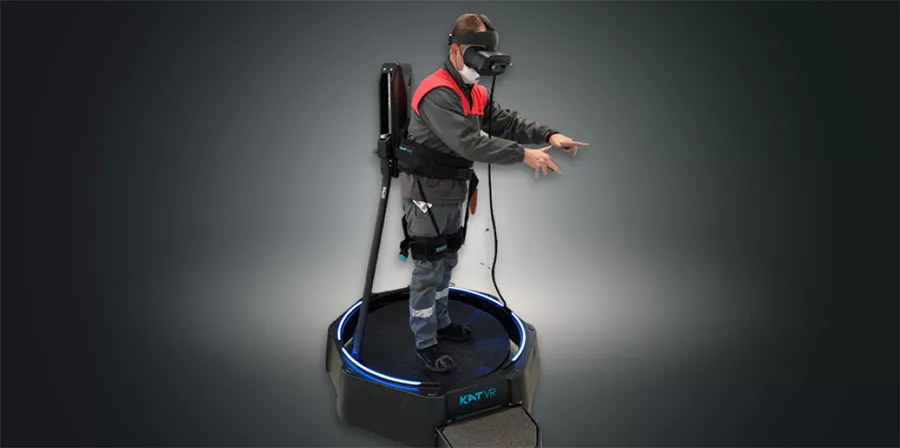Teleportation in virtual reality allows users to move from one location to another in the virtual environment without physically moving in the real space. While teleportation is widely used in VR applications to mitigate potential issues with cyber-sickness or disorientation associated with traditional locomotion methods like walking, it is not realistic and can reduce the quality of user immersion.
To achieve a realistic sense of movement and a perfect sense of immersion, the use of motion tracking devices is necessary. Instead of staying in one place or using the gamepad controls of the headset to move around, room-scale VR allows users to naturally navigate and move within the virtual environment.
Walking in VR: Challenges to Overcome
Walking in virtual reality poses several significant challenges that need to be addressed.
The first and foremost challenge is, of course, the quality of immersion. One of the main goals of VR is indeed to create an immersive experience that gives the impression of truly being in another environment. Non-natural or clumsy ambulation breaks immersion and diminishes the quality of the experience. Ideally, for a truly immersive experience, ambulation in VR should be natural or even mimic the way we move in the real world.
The second challenge is the discrepancy between the visual perception of movement in VR and the potential absence of actual physical movement, which can cause a form of motion sickness. The term “simulator sickness” or “cyber-sickness” is used to describe the symptoms such as nausea, dizziness, and headaches that some people experience when using virtual reality headsets. Several studies have been conducted to understand the mechanisms behind simulator sickness and propose solutions, such as the use of locomotion systems or manipulation of peripheral vision.
Finally, VR locomotion devices need to address issues of security comfort and safety (users may stumble upon real objects, collide with walls or people, etc.); they should be able to fit into a limited space (users need to explore large virtual environments while remaining in a small physical space ) and be available to the largest number (elderly individuals, people with reduced mobility,… ).
Walking in VR: a constant research topic.
For the past decade, researchers and companies worldwide have been working on these challenges to improve walking in VR. Several techniques have been developed, such as:
- Omnidirectional locomotion systems: They allow users to move in all directions without having to change their physical orientation.
- Real-walking-based locomotion systems: They allow users to walk in place to navigate through the virtual environment.
- Position-based locomotion systems: They enable the user to navigate through a virtual reality environment by using body movements captured by position sensors.
Indeed, from an economic standpoint, virtual reality locomotion systems that enable natural and realistic movement within a virtual environment are expected to have a significant impact on the gaming industry and professional training. Yes, it would indeed lead to better acceptance by everyone who wouldn’t have to learn teleportation anymore.
Deambulation – Virtuix omni one
The ORANO Group has been collaborating with the AUDACE teams for 12 years, resulting in the production of more than fifty projects in the nuclear field. Recently, AUDACE has developed a simulator called “JUMPER.” This device offers an intervention experience in the heart of a highly radioactive confined space.
The learner practices “jumping,” intervening, and exiting a steam generator to replace a “vital” component, the tape. They must perform their work according to the expected standard while minimizing their exposure to radiation as much as possible. Very anxiety-inducing, the virtual reality simulation recreates both the feeling of claustrophobia, the manipulation with limited light, and the imperative of speed of execution that the collaborator must demonstrate.
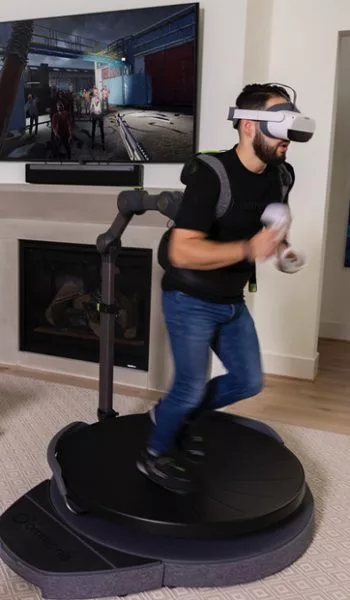
Comparison table of the "pros and cons" of the Virtuix Omni One treadmill
Benefits | Disadvantages |
|---|---|
Provides an immersive VR walking experience | Relatively high cost (around 1800€) |
Possibility of omnidirectional movement | Bulky and requires dedicated space |
Use of special shoes for a better walking sensation | Requires a learning period for optimal use |
Ability to sit down and stand up easily thanks to a pivoting platform | Not suitable for individuals with mobility issues |
Offers a motion control system for a smoother experience | May lead to muscle fatigue and soreness after prolonged use |
Easy to install and use at home
|
Deambulation – Kat Walk C2
KatVR, a Chinese start-up, based in Hangzhou, offers its locomotion device called “Kat Walk C2.” It is an omnidirectional walking platform that allows users to walk, run, jump, and crouch in virtual reality. The device consists of a circular platform equipped with a safety harness, which is connected to a central support, allowing the user to move freely in all directions. The motion sensors integrated into the platform track the user’s body movements, while the pressure sensors embedded in the surface of the platform record the movements of the user’s feet.
KAT VR is among the winners of the 2023 IF Design Award, an internationally renowned industrial design award. KAT WALK C2 stood out for its creative design and the quality of the immersive experience it offers.
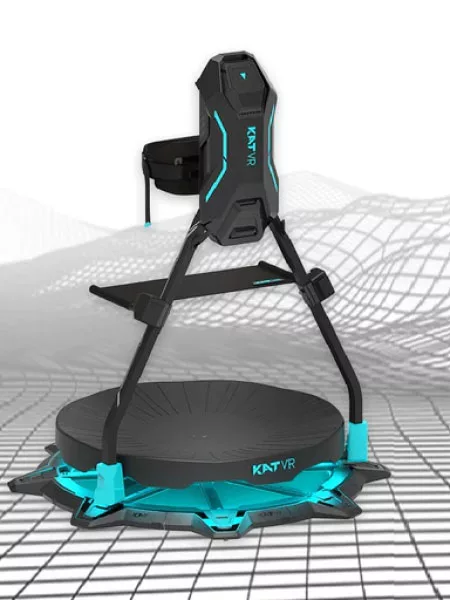
Comparison table of the "pros and cons" of the kat walk c2 treadmill
Benefits | Disadvantages |
|---|---|
Omnidirectional walking device, allowing 360-degree freedom of movement. | The harness system can be cumbersome and uncomfortable for some individuals. |
The motion platform is lightweight and compact, providing a more immersive experience without taking up too much space. | Requires a learning curve to become familiar with the walking device. |
Can be used with accessories such as virtual weapons for more immersive gaming experiences. |
Déambulation – Infinadeck experience platform
The California-based company Infinadeck has created its “Infinadeck Experience Platform,” an omnidirectional walking system that allows users to walk in all directions without leaving the platform. The system consists of a walking platform equipped with freely moving treadmills, as well as a harness that allows the user to walk or run in any direction safely.
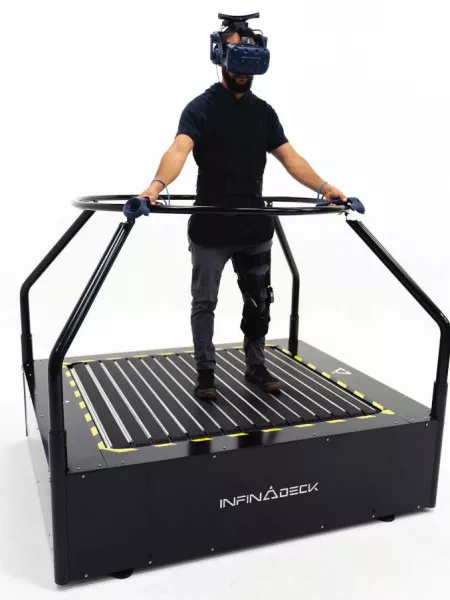
Comparison table of the "pros and cons" of the infinadeck expérience platform treadmill
Benefits | Disadvantages |
|---|---|
Unlimited freedom of movement in all directions is possible without any limitations. | Unlimited freedom of movement in all directions is possible without any limitations. |
Robust design for intensive use in enterprise settings. | Significant space requirement, requiring a dedicated area for installation. |
Highly precise position and direction detection system. | Limited to basic locomotion movements, without the ability to run or jump. |
Customization options available to meet the user’s specific needs. | Requires some time for beginners to adapt. |
Intuitive user interface for easy movement control. |
Déambulation – virtualizer elite 2
The Virtualizer ELITE 2 is a virtual reality walking device based on real walking, manufactured by the Austrian company Cyberith. The Virtualizer ELITE 2 allows for complete freedom of movement: users can move in all directions by walking, running, or jumping. The device is equipped with sensors that track the movements of the user’s feet and transmit the data to a computer to synchronize them in the virtual environment.
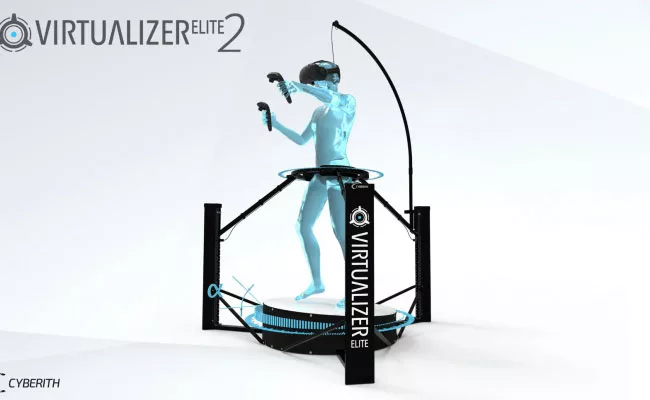
Comparison table of the "pros and cons" of the virtualizer elite 2 treadmill
Benefits | Disadvantages |
|---|---|
It uses natural walking as the movement system, providing a more realistic immersion in the virtual environment. | Requires a fairly large space for use. |
Supports both virtual reality and augmented reality. | Fairly bulky and challenging to store. |
Features motion sensors to track body and feet movements. | Higher price (+€4000) |
Allows for walking in all directions, offering great freedom of movement. | May require a learning period to get used to walking on the walking platform. |
Provides handles for balance and stability, ensuring the safety of the user, and has a removable seat for added comfort during extended sessions. | Wearing the harness can be uncomfortable for some users. |
Deambulation – cybershoes
Launched in 2018 through a crowdfunding campaign on Kickstarter, Cybershoes, a virtual reality accessory by the Austrian startup of the same name, are devices for walking-based locomotion in virtual reality. Users wear the Cybershoes (a type of overshoe) on their feet and then sit on a chair and slide their feet on the ground as if they were walking. The shoes are equipped with motion sensors that record direction and speed, and this information is transmitted to the computer to synchronize the movement of the virtual character.
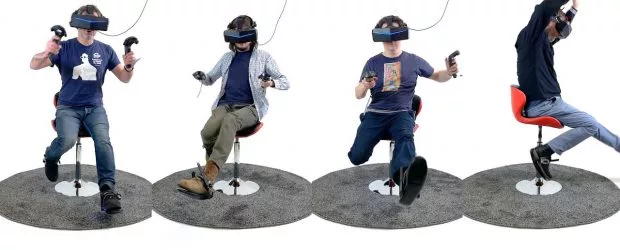
Comparison table of the "pros and cons" of the cybershoes
Benefits | Disadvantages |
|---|---|
A compact and lightweight design makes it easy to use and store. | A limited walking system that does not allow for omnidirectional movement. |
An affordable approach compared to other locomotion systems, with a purchase price of approximately €350. | Requires a chair or stool for sitting. |
Compatibility with most virtual reality headsets. | Continuous foot movement can eventually lead to user fatigue. |
A smooth and precise movement system that utilizes the user’s natural walking motion. | Requires a special mat to protect the floors and the user’s shoes. |
An immersive and realistic gaming experience that allows users to truly feel present in the virtual world. |
Deambulation – stridervr
The StriderVR is a device for real-walking-based locomotion developed by researchers from Düsseldorf. It enables walking, running, jumping, and crouching in a virtual reality experience. It utilizes a circular treadmill, a safety harness, and motion sensors to enable full immersion for the player. The player’s movements are captured by motion sensors placed on the harness and translated into the game.
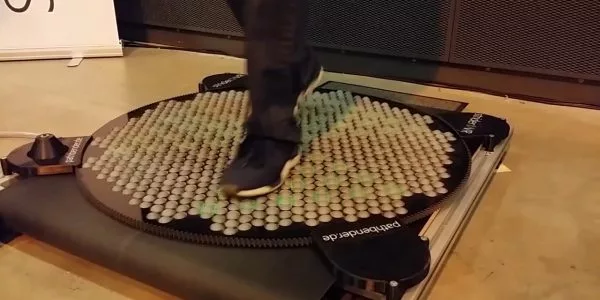
Comparison table of the "pros and cons" of the stridervr treadmill
Benefits | Disadvantages |
|---|---|
The StriderVR is based on real walking, which allows for an immersive and realistic experience. | The StriderVR is relatively expensive compared to other locomotion devices, which can be a deterrent for potential users (approximately €2250 in 2021). |
It uses a system of sensors to track the user’s body movements and translate them into in-game movements, providing a high level of movement accuracy. | The device requires a dedicated and sufficiently large play area for users to move freely, which can be a challenge for some users. |
It is compatible with a wide variety of games and platforms. | As it is based on real walking, the StriderVR can be tiring for users who are not accustomed to walking for long periods of time. |
The StriderVR is easy to assemble and use, with an intuitive user interface for adjusting settings and calibrations. | The device may not be suitable for individuals with mobility issues or disabilities, as it requires a certain level of agility and physical fitness. |
The device is compact and portable, allowing for easy storage when not in use. | Some users have reported stability and slipping issues when using the StriderVR, especially on slippery surfaces. |
The Audace experience: the Kat Walk Mini for “Bridgestone”.
Bridgestone approached Audace to design an innovative virtual reality device: a tire manufacturing simulator. This device offers several advantages such as a training in technical skills for assembly line operators prior to their start of work without impacting their productivity, optimal safety, a progressive and stress-free experience for new employees without industrial experience (career transition or young workers), and the ability to train a more diverse group, including women.
Audace has recreated seven complete machine tools at a 1:1 scale to create a training experience as close to reality as possible. In this fully simulated “digital factory,” learners can practice mastering the necessary technical skills. They only need a virtual reality headset to undergo training. To facilitate their movement within the virtual factory, the device is associated with a walking pad. The KatWalk Mini treadmill was chosen for this purpose.
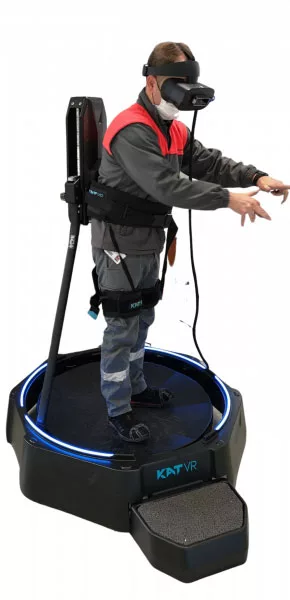
"Pros & Cons" Comparison Table of the KatWalk Mini Treadmill (reference: Audace)
Benefits | Disadvantages |
|---|---|
Assembly of the components to create the device | Use of the manufacturer’s software |
Calibration of the system using the provided documentation | Difficulty at the beginning for the movements on it |
Quick setup on the development side | Time required to onboard a new learner on the simulator |
Quick contact with manufacturers via WhatsApp | |
Integration of realistic movement into the simulation |
Conclusion
Over the past 10 years, virtual reality locomotion has made significant progress. Position-based, real-walk, and omnidirectional-based locomotion devices provide diverse immersive experiences for users. In 2023, brands like Virtuix, Kat Walk, Infinadeck, Cybershoes, and StriderVR offer locomotion devices that adequately cater to the different needs of users. Indeed, the pursuit of optimal immersion is driving rapid advancements in virtual reality locomotion technology, with new innovations and constant improvements being made. Developers are exploring solutions to make the experience more realistic, intuitive, and immersive.
